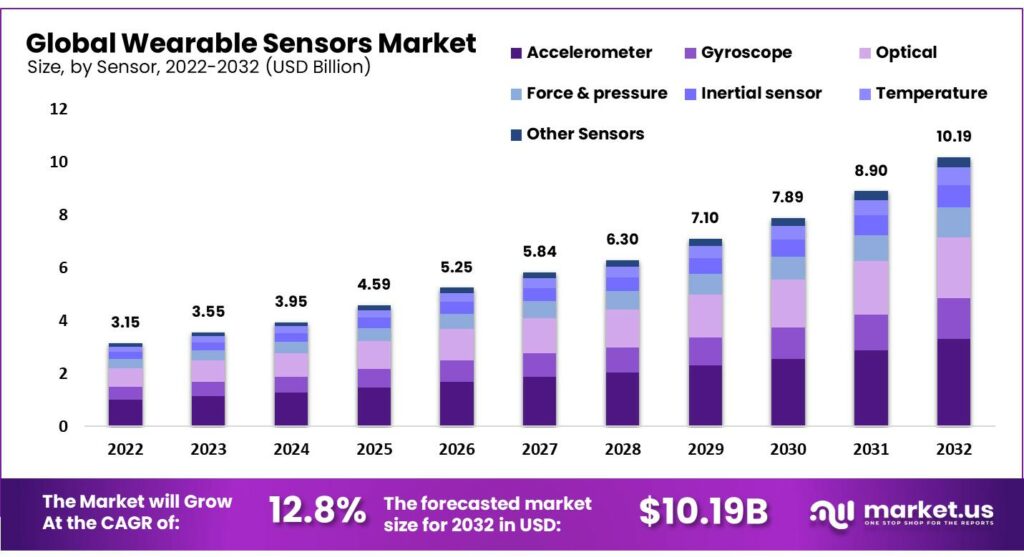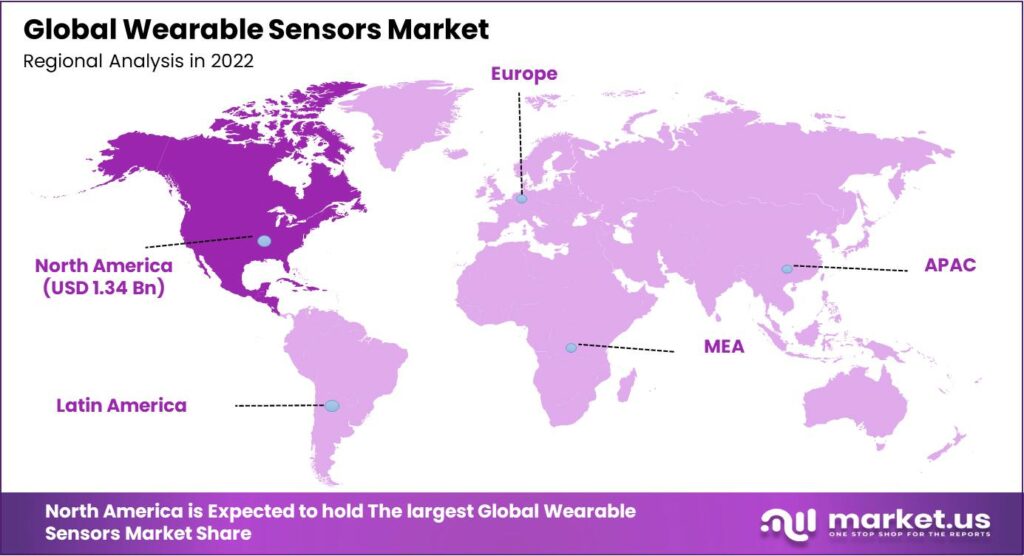
Wearable Sensors Market towards a USD 10.19 billion in 2032
Introduction
The global wearable sensors market is poised for significant growth, projected to reach a value of USD 10.19 billion by 2032, with a steady Compound Annual Growth Rate (CAGR) of 12.8% between 2023 and 2032. Wearable sensors are integral components of wearables designed to monitor health and fitness parameters, including blood pressure and glucose levels. These sensors enable real-time data collection on health and fitness metrics, facilitating monitoring and analysis by consumers and healthcare professionals alike.
Several factors are driving the growth of the wearable sensors market. Increasing consumer awareness of health and fitness, coupled with the prevalence of chronic diseases, is contributing to the demand for wearable sensor devices. Additionally, advancements in sensor technology and artificial intelligence are further fueling market growth. The healthcare industry’s adoption of remote monitoring solutions is also a significant driver of demand for wearable sensor devices.
Click to Request Sample Report and Drive Impactful Decisions: https://market.us/report/wearable-sensors-market/request-sample/

Key Takeaways
- Market Growth Projection: The global wearable sensors market is expected to reach USD 10.19 billion by 2033, with a steady Compound Annual Growth Rate (CAGR) of 12.8% between 2023 and 2032.
- Dominant Sensor Type: Accelerometers dominate the market with a 32.4% market share and a CAGR of 12.7%.
- Rapid Growth Segment: Optical sensors are expected to experience rapid growth with a CAGR of 13.4%.
- Popular Device: Fitness bands accounted for the largest revenue share in 2022 (38.7%).
- Fastest-Growing Device Segment: Smartwatches are projected to be the fastest-growing segment with a CAGR of 14.4%.
- Significant Vertical: The consumer segment holds the significant share in the wearable sensors market (44.5%) and is the fastest-growing with a CAGR of 13.7%.
- Regional Dominance: North America accounted for the largest revenue share in 2022 (42.7%), while Asia-Pacific is expected to be the fastest-growing region with a CAGR of 13.8%.
Factors affecting the growth of the Wearable Sensors Market
The growth of the wearable sensors market is influenced by a multitude of factors, spanning technological advancements, consumer preferences, regulatory landscapes, and economic conditions. Each of these factors contributes significantly to the expansion and development of the market.
- Technological Advancements: The continuous evolution of sensor technology, including improvements in accuracy, size reduction, and power efficiency, plays a critical role. As sensors become more advanced, their applications in wearable devices expand, driving greater adoption across various sectors, including healthcare, fitness, and consumer electronics.
- Healthcare Applications: A significant driver of growth in the wearable sensors market is the increasing use of these devices in healthcare for continuous health monitoring and disease management. The rise in chronic diseases and the aging population are prompting more widespread use of wearable technology for patient care.
- Consumer Demand: As consumers become more health-conscious, there is a noticeable increase in the demand for devices that offer real-time feedback on personal health and fitness. This trend is particularly strong in urban areas where lifestyle diseases are prevalent and consumers are keen on fitness and wellness monitoring.
- Cost Reduction: The reduction in the cost of production and raw materials for sensors allows manufacturers to offer more affordable wearable devices. Lower prices increase consumer accessibility and drive market growth.
- Regulatory and Privacy Concerns: Regulatory frameworks and privacy issues regarding data security significantly impact the market. Stricter regulations can either hinder growth by imposing burdensome compliance costs or stimulate market confidence by ensuring data protection and boosting consumer trust.
- Integration with IoT and Data Analytics: The integration of wearable sensors with the Internet of Things (IoT) and enhanced data analytics capabilities is facilitating new applications in smart technology and personal health ecosystems. This integration enables more comprehensive data collection and analysis, leading to better health outcomes and more personalized user experiences.
Elevate Your Business Strategy! Purchase the Report for Market-Driven Insights
Regional Analysis
North America holds a leading position in the global wearable sensors market, with the highest revenue share of 42.7%. This dominance is driven by several factors, including advanced technology infrastructure, high consumer awareness of health and fitness, and significant investment in healthcare innovation. The region benefits from the presence of major technology companies and a strong culture of health monitoring and fitness tracking, which boosts the demand for wearable sensors.
On the other hand, the Asia-Pacific (APAC) region is expected to experience the fastest growth in the wearable sensors market during the forecast period, with an impressive compound annual growth rate (CAGR) of 13.8%. This rapid growth is likely fueled by increasing technological adoption, rising disposable incomes, and expanding health consciousness among the population. Additionally, APAC’s large and young population offers a substantial consumer base for wearable technology, further accelerating market expansion in this region. As these trends continue, APAC is poised to become a key player in the global market for wearable sensors

Market Segment Analysis
By Sensor Analysis
In the global wearable sensors market, the accelerometer segment holds a prominent position, commanding a market share of 32.4% and experiencing a growth rate with a compound annual growth rate (CAGR) of 12.7%. This dominance can be attributed to the versatile application of accelerometers in a wide range of wearable devices, offering motion tracking and orientation features essential for both fitness tracking and medical monitoring.
The optical sensors segment has seen a swift rise in popularity, achieving a CAGR of 13.4%. This growth is primarily due to the increasing incorporation of optical sensors in wearable devices, which are crucial for monitoring physiological parameters such as heart rate and blood oxygen levels, enhancing both the functionality and appeal of wearable technology.
By Device Analysis
In terms of devices, the fitness band segment is projected to maintain its lead in the market, with a market share of 38.7% and a forecasted CAGR of 12.6% during the analyzed period. Fitness bands continue to be popular due to their affordability, user-friendliness, and focused health and fitness tracking features.
Conversely, the smartwatch segment is anticipated to be the fastest-growing category, with a projected CAGR of 14.4%. Smartwatches are becoming increasingly sophisticated, integrating a broader array of sensors and connectivity options, which make them appealing for a wide demographic seeking comprehensive health insights and connectivity on the go.
By Vertical Analysis
The consumer segment is expected to dominate the wearable sensors market, with a commanding market share of 44.5% and a growth rate of 13.7%. This segment’s expansion is driven by the surge in popularity of consumer-focused wearable technologies such as wrist-worn virtual reality (VR) headsets and smart clothing. These innovations cater to a growing demand for integrated, interactive personal technology solutions, propelling rapid growth in this vertical.
Driver: Increasing Health Consciousness Among Consumers
The growing awareness of health and wellness among consumers worldwide serves as a significant driver for the wearable sensors market. As individuals become more proactive about their health, there is a notable shift towards adopting technologies that enable regular monitoring of physical activities and vital signs. Wearable sensors embedded in devices like fitness bands and smartwatches allow users to track their health metrics such as heart rate, activity levels, and sleep patterns in real-time. This trend is further fueled by the rise in lifestyle diseases and a growing emphasis on preventive healthcare, driving demand for wearable technology that supports a healthier lifestyle.
Restraint: Privacy and Data Security Concerns
Privacy and data security issues pose significant restraints to the growth of the wearable sensors market. Wearable devices collect a vast amount of personal health data, which raises concerns about the potential misuse of sensitive information. The apprehension regarding data breaches and unauthorized access to personal health records can deter consumers from adopting wearable technology. Additionally, the lack of stringent and unified regulations governing data security across different regions adds to consumer skepticism. Addressing these concerns is crucial for maintaining consumer trust and encouraging wider acceptance of wearable devices.
Opportunity: Integration with Telemedicine and E-Health Services
The integration of wearable sensors with telemedicine and e-health services presents a substantial opportunity for market expansion. As healthcare systems increasingly adopt digital solutions, wearable sensors can play a pivotal role in remote patient monitoring and management. These devices enable continuous health tracking, which can be vital for chronic disease management and preventive care. The data collected through wearable sensors can be directly utilized by healthcare providers to offer timely medical interventions and personalize treatment plans, thus enhancing patient outcomes and optimizing healthcare resources.
Challenge: Technological and Design Limitations
A major challenge facing the wearable sensors market is the technological and design limitations of current devices. While there is a demand for smaller, more efficient, and more accurate sensors, achieving this can be technically challenging. The need to balance device size, battery life, and functional complexity without compromising user comfort and device performance is a significant hurdle. Additionally, ensuring that these devices remain aesthetically pleasing while incorporating advanced functionalities is crucial for consumer adoption but remains a difficult feat for manufacturers. Addressing these design and technological challenges is essential for the continued innovation and user engagement in the wearable sensors market
Key Market Segments
Based on Sensor
- Accelerometer
- Gyroscope
- Optical
- Force & pressure
- Inertial sensor
- Temperature
- Other Sensors
Based on Device
- Smartwatch
- Fitness band
- Smart glasses
- Smart fabric
- Smart footwear
- Other Devices
Based on Vertical
- Consumer
- Defense
- Healthcare
- Industrial
- Other Verticals
Key Players
- Robert Bosch GmbH
- STMicroelectronics N.V.
- Texas Instruments Incorporated
- Infineon Technologies AG
- Analog Devices Inc.
- InvenSense Inc. (TDK Corporation)
- Infineon Technologies AG
- InvenSense Inc.
- Other Key Players
Key Regions and Countries Covered in this Report:
- North America
- The US
- Canada
- Europe
- Germany
- France
- The UK
- Spain
- Italy
- Russia
- Netherland
- Rest of Europe
- APAC
- China
- Japan
- South Korea
- India
- Australia
- New Zealand
- Singapore
- Thailand
- Vietnam
- Rest of APAC
- Latin America
- Brazil
- Mexico
- Rest of Latin America
- Middle East and Africa
- South Africa
- Saudi Arabia
- UAE
- Rest of MEA
Contact Data
Global Business Development Teams – Market.us
Market.us (Powered By Prudour Pvt. Ltd.)
Email: inquiry@market.us
Address: 420 Lexington Avenue, Suite 300 New York City, NY 10170, United States
Tel: +1 718 618 4351
Website: https://market.us/
Explore More Reports
- Predictive Maintenance Market is likely to reach a valuation of USD 107.3 billion by 2033, expected to garner a CAGR of 28.3%.
- Cybersecurity Insurance Market is set to reach USD 62.7 billion by 2032, predicted to expand at a CAGR of 18.8% till 2032.
- AI Training Dataset Market was valued at USD 1.9 Billion in 2022. This market is estimated to register the highest CAGR of 20.5%.
- WiFi 6, WiFi 6E and WiFi 7 Chipset Market size is expected to be worth around USD 101.0 Billion by 2033, growing at a CAGR of 14.6%.
- AI Trust, Risk and Security Management (AI TRiSM) Market is estimated to reach USD 8.4 billion by 2033, Riding on a Strong 16.0% CAGR.
- AI In Fashion Market is estimated to reach USD 23,936.3 Million by 2033, Riding on a Strong 40.5% CAGR throughout the forecast period.
- AI Chip Market is estimated to reach USD 341 billion by 2033, Riding on a Strong 31.2% CAGR throughout the forecast period.
- AI in social media market is estimated to reach USD 22,396.8 Million by 2033, Riding on a Strong 28.37% CAGR throughout the forecast period.
- Generative AI in Chemical Market is estimated to reach USD 2,289.7 Million by 2033, Riding on a Strong 27.8% CAGR during the forecast period.
- Generative AI In Manufacturing Market is estimated to reach USD 10,540.1 Mn by 2033, Riding on a Strong 42% CAGR during forecast period.
Editor Details
-
Company:
- Wired Release
- Website:
